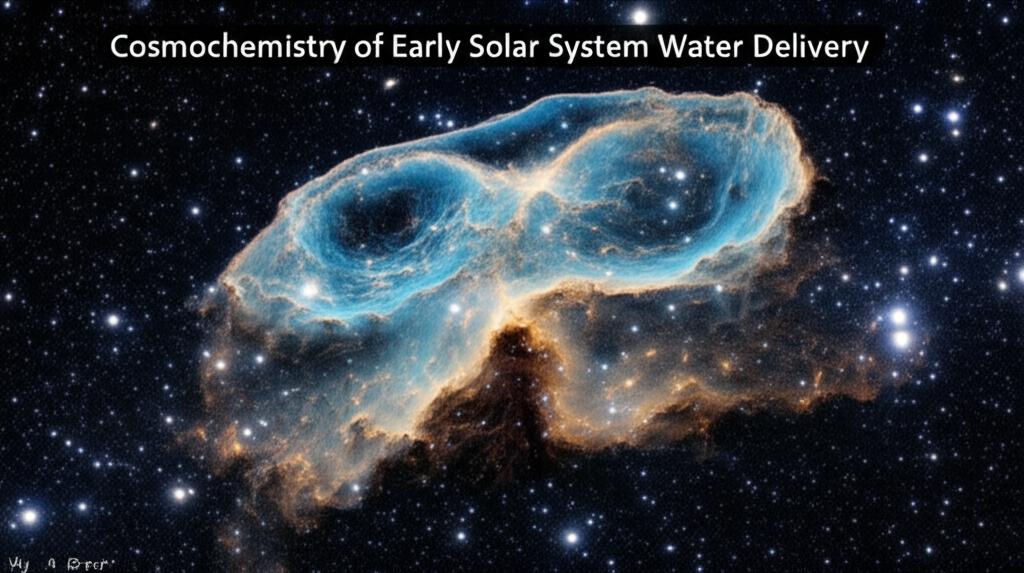Understanding how Earth became a water-rich planet is a central question in planetary science. Located in the inner Solar System, Earth formed in a region thought to be too hot for water ice to readily condense. This suggests that the bulk of our planet's water was likely delivered later or formed through specific processes during its early history. Cosmochemistry, particularly the analysis of isotopic ratios, provides crucial clues to unraveling this mystery.
A key tool in this investigation is the deuterium-to-hydrogen (D/H) ratio, which acts like a chemical fingerprint for water from different parts of the Solar System. Deuterium, a heavier isotope of hydrogen, is enriched in water formed at very cold temperatures, farther from the Sun. Earth's ocean water has a precisely measured D/H ratio (approximately 1.56 x 10⁻⁴), serving as a benchmark for comparison.
For a long time, asteroids, specifically a class called carbonaceous chondrites, have been considered the primary source of Earth's water. These meteorites, originating mainly from the outer asteroid belt, possess D/H ratios very similar to terrestrial oceans. Studies of ancient meteorites, including some from the asteroid Vesta and others found containing liquid water inclusions, further support the idea that these bodies delivered significant amounts of water, likely via unmelted, chondritic meteorites impacting the early Earth. Research suggests melted meteorites (achondrites) are extremely dry, indicating that the melting process experienced by larger planetesimals leads to near-total water loss.
The role of comets has been more debated. Initial measurements of many comets, particularly those originating from the distant Oort Cloud, showed D/H ratios roughly twice that of Earth's oceans. This led researchers to conclude that comets likely contributed less than 10% of Earth's water inventory. However, Jupiter-family comets (JFCs), which mostly originate from the Kuiper Belt beyond Neptune, show more complex results. Some JFCs, like 103P/Hartley 2, have Earth-like D/H ratios. A significant recent development involves Comet 67P/Churyumov–Gerasimenko. Initial measurements by the Rosetta spacecraft indicated a D/H ratio three times higher than Earth's, seemingly reducing the likelihood of JFCs being a major source. However, newer analyses suggest these measurements might have been skewed by deuterium-rich water ice sticking to dust grains in the comet's coma (the atmosphere around the nucleus). When accounting for this dust interference, the re-evaluated D/H ratio of Comet 67P appears much closer to Earth's value, reopening the possibility that JFCs played a substantial role in water delivery. Additionally, observations of hyperactive comets, which expel icy grains, also show Earth-like D/H ratios.
Beyond extraterrestrial delivery, other theories propose that Earth may not have formed completely dry. Interactions between hydrogen-rich atmospheres and magma oceans on the planetary embryos that accreted to form Earth could have generated substantial amounts of water in situ. Evidence from meteorites called enstatite chondrites, which have isotopic compositions similar to Earth's building blocks, indicates they contained enough hydrogen to potentially form significant water, suggesting our planet could have acquired water during its primary accretion. Analysis of ancient zircons suggests liquid water existed on Earth as early as 4.4 billion years ago, very soon after its formation. Furthermore, some deep-mantle rocks contain water with a slightly lower D/H ratio, hinting at a contribution from the early solar nebula gas incorporated into the Earth.
Other potential contributors include the solar wind. This stream of charged particles from the Sun can implant hydrogen ions onto the surface of dust grains in space. Chemical reactions with oxygen in the silicate minerals can form water molecules directly on these grains. This "space weathered" water tends to have a lower D/H ratio and could have been delivered to Earth via perpetual infall of interplanetary dust, potentially contributing to Earth's overall water budget and explaining some isotopic characteristics. The massive impact event that formed the Moon, involving the collision of the proto-Earth with a Mars-sized body named Theia, might also have played a role if Theia originated from the outer Solar System and carried water.
The timing of water delivery is also debated. Some models favor "late accretion," suggesting water arrived primarily towards the final stages of Earth's formation, possibly after the Moon-forming impact. Other evidence points to water being present much earlier.
In conclusion, the cosmochemical evidence suggests Earth's water likely originates from multiple sources. Carbonaceous chondrite-like asteroids remain strong candidates for the primary delivery mechanism. However, recent re-evaluations have revived the potential for a significant contribution from Jupiter-family comets. Additionally, primordial water incorporated during accretion, water generated through early planetary processes like magma ocean-atmosphere interactions, and contributions from solar wind interacting with space dust all potentially played a role. Unraveling the precise contributions of each source remains an active area of research, continually refined by new analyses of meteorites, cometary data, and sophisticated modeling of early Solar System processes.

